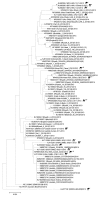MERS-CoV in Upper Respiratory Tract and Lungs of Dromedary Camels, Saudi Arabia, 2013-2014
- PMID: 26079346
- PMCID: PMC4480395
- DOI: 10.3201/eid2107.150070
MERS-CoV in Upper Respiratory Tract and Lungs of Dromedary Camels, Saudi Arabia, 2013-2014
Abstract
To assess the temporal dynamics of Middle East respiratory syndrome coronavirus (MERS-CoV) infection in dromedary camels, specimens were collected at 1-2 month intervals from 2 independent groups of animals during April 2013-May 2014 in Al-Ahsa Province, Saudi Arabia, and tested for MERS-CoV RNA by reverse transcription PCR. Of 96 live camels, 28 (29.2%) nasal swab samples were positive; of 91 camel carcasses, 56 (61.5%) lung tissue samples were positive. Positive samples were more commonly found among young animals (<4 years of age) than adults (>4 years of age). The proportions of positive samples varied by month for both groups; detection peaked during November 2013 and January 2014 and declined in March and May 2014. These findings further our understanding of MERS-CoV infection in dromedary camels and may help inform intervention strategies to reduce zoonotic infections.
Keywords: MERS-CoV; Middle East Respiratory syndrome; Saudi Arabia; abattoir; coronavirus; dromedary camels; viruses; zoonoses.
Figures


References
-
- Albarrak AM, Stephens GM, Hewson R, Memish ZA. Recovery from severe novel coronavirus infection. Saudi Med J. 2012;33:1265–9 . - PubMed
Publication types
MeSH terms
LinkOut - more resources
Full Text Sources
Other Literature Sources
Miscellaneous

